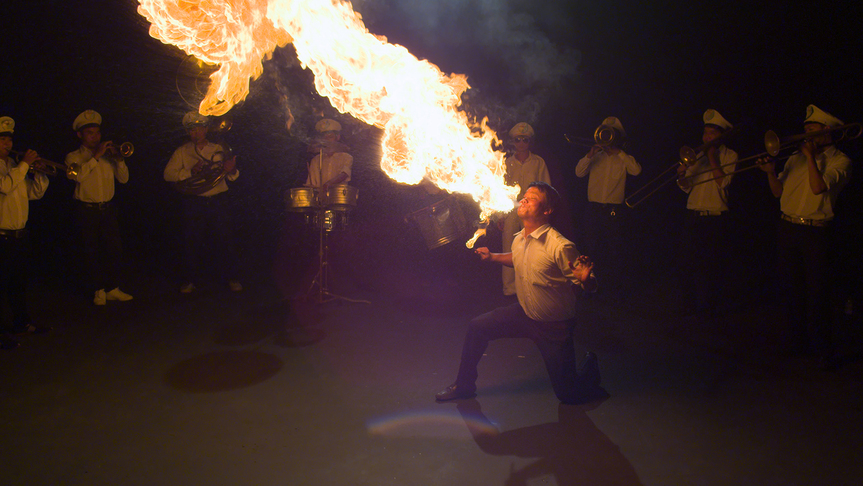-
From Current Issue
-
- Editor’s Letter Fire in the Heart
- Reviews I Gusti Ayu Kadek Murniasih
- Reviews 11th Seoul Mediacity Biennale: “One Escape at a Time”
- Dispatch Networked China
- One on One Monira Al Qadiri on Yukio Mishima
- Essays The rise of independent art spaces in pandemic-era Shanghai
- Features Tuan Andrew Nguyen
- Table of Contents
- Web Exclusives
- Archive
- Subscribe

R
E
V N
E
X
T
In the exhibition “New Pictures: The Propeller Group, Reincarnations,” a group show comprising classical pieces in the Mia collection and contemporary work by The Propellor Group (TPG) at the Minneapolis Institute of Art (Mia), visitors were hypnotized with a mysterious sense of the spiritual. Ritualistic and sacred objects culled from cultures across the globe, and over vast centuries, were arranged like a globalized procession of ghosts. Masks, snakes, statues of deities and other spiritual iconography—some altered or newly created by TPG—all stood at the ready, as if about to march together to the great beyond. In contrast with the larger, much more prominently advertised traveling survey show of TPG making its way across the United States, the exhibition at Mia was much more condensed and focused on stirrings of the phantasmagorical, a theme present in much of TPG’s work.
This mysterious cast of characters faced a screen at the front of the darkened gallery room, where The Living Need Light, the Dead Need Music (2014) a short film by TPG, was playing in a loop. First screened at the New Orleans Biennial in 2014, the surrealist film is based on funerary processions and rituals in Vietnam, where the members of TPG—Phunam Thuc Ha, Matt Lucero, and Tuan Andrew Nguyen—is based. Set to a score that fuses rhythmic and trance-like traditional Vietnamese music with jazz and Western pop music—including a fast-paced, brass band remix of the 2008 song Trouble is A Friend by Australian singer Lenka—the film explores cultural exchange and celebrates the majesty of spectacle and tradition.
The cinematic, sleek quality of the footage reveals both The Propeller Group’s former operations as an ad agency in Vietnam—an ingenious ploy to avoid censorship—as well as the country’s tropical landscape and watery channels, juxtaposed with scenes in narrow urban streets and warehouses. The film follows a group of outsiders—a transgender youth, a snake-swallowing performer, and a scruffy bandleader—as they perform ceremonies filled with eye-catching feats of acrobatics, magnificent tricks and marches. Masterful and poignant, the work’s strength is in its presentation of these intriguing, vulnerable, characters.
For those who stayed to watch the full 20 minutes of the film, invisible connections between the moving image and the static, processional installation subtly but slowly materialized. For example, at the front of the procession was a Bodhisattva sculpture from late 6th century China in which TPG circled with a “ring of fire” newly crafted from gold-gilded wood. The figure mirrors the literal flames that engulf Sam, a transgender character in the film, and is a “collaboration” between TPG and the original 6th century artist. Like the Bodhisattva surrounded by fire, Sam is trapped between different worlds—between genders, and between life and death. In a symbolic celebration of life and death near the end of the film, Sam vanishes in the fire.
The theme of rewriting narratives was also felt strongly throughout the film and the exhibition, highlighted by TPG’s contemporary additions to and “collaborations” with the artifacts. One such example of this was in a 3rd century Buddha statue from Pakistan, to which TPG added two sets of hands. One pair of hands acts as a replacement for the original, which might have crumbled away naturally or been destroyed in uprisings. This pair is held up, eerily, by a second set of hands, which are white and feature bracelets.
An original sculpture by TPG, titled We Devour our Worst Demons to Find our Greatest Fears (2017), also worked in dialog with the ancient objects presented in the installation. Featuring a giant ouroboros—a circular snake that eats its own tail—the work was a response to the myriad snake symbols found throughout the exhibition, including a snake-human zodiac figure from China, a staff with a snake wrapped around it from the United States, and a Mami Wata (water spirit) figure from Nigeria wrapped in a snake. Although the snake is seen as a spirit-leader and guide of the underworld in some cultures, TPG references another ancient belief here, in that the manifestation of the ouroboros signifies infinity, wholeness and recurrent energies.
The exhibition’s effect was chilling. Groups of school children entered, squealed and stood in awe of the pyrotechnics and spectacle of film, as well as the fearsome masks and sculptures assembled in the room. They then quickly backed away, as if the spiritual power was overwhelming. It was as if the assemblage of these pieces, in combination with the hypnotic spiritualism of the film, was calling an awakening of the dead within the walls of the museum.
“New Pictures: The Propeller Group, Reincarnations” runs through September 10, 2017, at the Minneapolis Institute of Art.
To read more of ArtAsiaPacific’s articles, visit our Digital Library.







